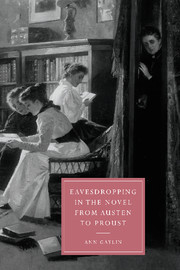Book contents
- Frontmatter
- Contents
- Acknowledgments
- Introduction
- 1 I'm all ears: Pride and Prejudice, or the story behind the story
- 2 Eavesdropping and the gentle art of Persuasion
- 3 Household words: Balzac's and Dickens's domestic spaces
- 4 The madwoman outside the attic: eavesdropping and narrative agency in The Woman in White
- 5 La double entente: eavesdropping and identity in A la recherche du temps perdu
- Conclusion: covert listeners and secret agents
- Notes
- Select bibliography
- Index
5 - La double entente: eavesdropping and identity in A la recherche du temps perdu
Published online by Cambridge University Press: 22 September 2009
- Frontmatter
- Contents
- Acknowledgments
- Introduction
- 1 I'm all ears: Pride and Prejudice, or the story behind the story
- 2 Eavesdropping and the gentle art of Persuasion
- 3 Household words: Balzac's and Dickens's domestic spaces
- 4 The madwoman outside the attic: eavesdropping and narrative agency in The Woman in White
- 5 La double entente: eavesdropping and identity in A la recherche du temps perdu
- Conclusion: covert listeners and secret agents
- Notes
- Select bibliography
- Index
Summary
Hearing is a physiological phenomenon; listening is a psychological act.
Barthes, The Responsibility of FormsNotre sagesse commence où celle de l'auteur finit, et nous voudrions qu'il nous donnât des réponses, quand tout ce qu'il peut faire est de nous donner des désirs.
Proust, Contre Sainte-BeuveIt is a critical commonplace to speak of Marcel Proust's visual sensibility. Numerous studies have focused on John Ruskin's influence on Proust, on the predominance of visual imagery, description, and perception in his novel, and on his theories about visual art in A la recherche du temps perdu. In a well-known and often-quoted phrase, Proust declared his art to be one of the telescope, not the microscope. Indeed, he compares well with the unnamed “romancier mondain” (“society novelist”) at la marquise de Saint-Euverte's soirée who answers the question “Qu'est-ce que vous pouvez bien faire ici?” (“What on earth are you doing here?”) by placing “au coin de son oeil un monocle, son seul organe d'investigation psychologique et d'impitoyable analyse” and responding, “d'un air important et mystérieux, en roulant l'r: – J'observe” (“into the angle of eyebrow and cheek a monocle that was his sole instrument of psychological investigation and remorseless analysis,” and responding, “with an air of mystery and self-importance, rolling the r, ‘I am observing!’”).
Less noticed, but equally important, is Proust's reliance on aural stimuli, perceptions, and sensations to evoke particular moments, scenes, or ressentiments that resound from “le violon intérieur” (“the violin within,” III: 18).
- Type
- Chapter
- Information
- Eavesdropping in the Novel from Austen to Proust , pp. 139 - 166Publisher: Cambridge University PressPrint publication year: 2003

